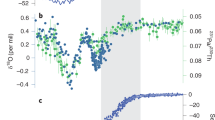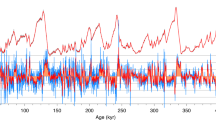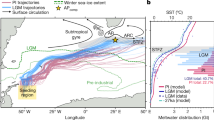Abstract
The Atlantic meridional overturning circulation (AMOC) transports warm salty surface waters to high latitudes, where they cool, sink and return southwards at depth. Through its attendant meridional heat transport, the AMOC helps maintain a warm northwestern European climate, and acts as a control on the global climate. Past climate fluctuations during the Holocene epoch (∼11,700 years ago to the present) have been linked with changes in North Atlantic Ocean circulation1,2. The behaviour of the surface flowing salty water that helped drive overturning during past climatic changes is, however, not well known. Here we investigate the temperature and salinity changes of a substantial surface inflow to a region of deep-water formation throughout the Holocene. We find that the inflow has undergone millennial-scale variations in temperature and salinity (∼3.5 °C and ∼1.5 practical salinity units, respectively) most probably controlled by subpolar gyre dynamics. The temperature and salinity variations correlate with previously reported periods of rapid climate change3. The inflow becomes more saline during enhanced freshwater flux to the subpolar North Atlantic. Model studies predict a weakening of AMOC in response to enhanced Arctic freshwater fluxes4, although the inflow can compensate on decadal timescales by becoming more saline5. Our data suggest that such a negative feedback mechanism may have operated during past intervals of climate change.
This is a preview of subscription content, access via your institution
Access options
Subscribe to this journal
Receive 51 print issues and online access
$199.00 per year
only $3.90 per issue
Buy this article
- Purchase on Springer Link
- Instant access to full article PDF
Prices may be subject to local taxes which are calculated during checkout



Similar content being viewed by others
References
Bond, G. et al. Persistent solar influence on north Atlantic climate during the Holocene. Science 294, 2130–2136 (2001)
Bianchi, G. G. & McCave, I. N. Holocene periodicity in North Atlantic climate and deep-ocean flow south of Iceland. Nature 397, 515–517 (1999)
Mayewski, P. A. et al. Holocene climate variability. Quat. Res. 62, 243–255 (2004)
Cubasch, U. & Meehl, G. in Climate Change 2001: The Scientific Basis (eds Houghton, J. T. et al.) 525–582 (Cambridge Univ. Press, 2001)
Hátún, H., Sando, A. B., Drange, H., Hansen, B. & Valdimarsson, H. Influence of the Atlantic subpolar gyre on the thermohaline circulation. Science 309, 1841–1844 (2005)
Hansen, B. & Østerhus, S. North Atlantic-Nordic Seas exchanges. Prog. Oceanogr. 45, 109–208 (2000)
Blindheim, J. & Østerhus, S. The Nordic Seas, main oceanographic features. Geophys. Monogr. 158, 11–37 (2005)
Came, R. E., Oppo, D. W. & McManus, J. F. Amplitude and timing of temperature and salinity variability in the subpolar North Atlantic over the past 10 ky. Geology 35, 315–318 (2007)
Lamb, H. H. Climatic variation and changes in the winds and ocean circulation: The Little Ice Age and the Northeast Atlantic. Quat. Res. 11, 1–20 (1979)
Andersen, K. K. et al. High-resolution record of Northern Hemisphere climate extending into the last interglacial period. Nature 431, 147–151 (2004)
Barker, S., Greaves, M. & Elderfield, H. A study of cleaning procedures used for foraminiferal Mg/Ca paleothermometry. Geochem. Geophys. Geosyst. 4, 8407–8427 (2003)
Barker, S., Cacho, I., Benway, H. & Tachikawa, K. Planktonic foraminiferal Mg/Ca as a proxy for past oceanic temperatures: a methodological overview and data compilation for the Last Glacial Maximum. Quat. Sci. Rev. 24, 821–834 (2005)
Schmidt, G. A. Error analysis of paleosalinity calculations. Paleoceanography 14, 422–429 (1999)
Ganssen, G. M. & Kroon, D. The isotopic signature of planktonic foraminifera from NE Atlantic surface sediments: implications for the reconstruction of past oceanic conditions. J. Geol. Soc. Lond. 157, 693–699 (2000)
Cléroux, C., Cortijo, E., Duplessy, J.-C. & Zahn, R. Deep-dwelling foraminifera as thermocline temperature recorders. Geochem. Geophys. Geosyst. 8 10.1029/2006GC001474 (2007)
Orvik, K. A. & Niiler, P. Major pathways of Atlantic water in the northern North Atlantic and Nordic Seas toward Arctic. Geophys. Res. Lett. 29, 1896–1900 (2002)
US National Oceanic and Atmospheric Administration. NODC (Levitus) World Ocean Atlas 1998. Earth System Research Laboratory, Physical Sciences Division 〈http://www.cdc.noaa.gov/〉 (1998)
Haug, G. H., Hughen, K. A., Sigman, D. M., Peterson, L. & Röhl, U. Southward migration of the intertropical convergence zone through the Holocene. Science 293, 1304–1308 (2001)
Solignac, S., de Vernal, A. & Hillaire-Marcel, C. Holocene sea-surface conditions in the North Atlantic - contrasted trends and regimes in the western and eastern sectors (Labrador Sea vs. Iceland Basin). Quat. Sci. Rev. 23, 319–334 (2004)
Rosenheim, B. E., Swart, P. K., Thorrold, S. R., Eisenhauer, A. & Willenz, P. Salinity change in the subtropical Atlantic: Secular increase and teleconnections to the North Atlantic Oscillation. Geophys. Res. Lett. 29 10.1029/2004GL021499 (2005)
Lund, D. C. & Curry, W. B. Late Holocene variability in Florida current surface density: Patterns and possible causes. Paleoceanography 19 10.1029/2004PA001008 (2004)
Cléroux, C. et al. Upper water column hydrology changes off Cape Hatteras and Gulf Stream activity over the Holocene. Eos 88 (Fall meeting), abstr. PP13B–1276.
Häkkinen, S. & Rhines, P. B. Decline of subpolar North Atlantic circulation during the 1990s. Science 304, 555–559 (2004)
Hillaire-Marcel, C., de Vernal, A., Bilodeau, G. & Weaver, A. Absence of deep-water formation in the Labrador Sea during the last interglacial period. Nature 410, 1073–1077 (2001)
deMenocal, P. B., Ortiz, J., Guilderson, T. & Sarnthein, M. Coherent high- and low-latitude climate variability during the Holocene Warm Period. Science 288, 2198–2202 (2000)
Dickson, R., Lazier, J., Meincke, J., Rhines, P. & Swift, J. Long-term coordinated changes in the convective activity of the North Atlantic. Prog. Oceanogr. 38, 241–295 (1996)
Schulz, M., Prange, M. & Klocker, A. Low-frequency oscillations of the Atlantic Ocean meridional overturning circulation in a coupled climate model. Clim. Past 3, 97–107 (2007)
Oppo, D. W., McManus, J. F. & Cullen, J. L. Deepwater variability in the Holocene epoch. Nature 422, 277–278 (2003)
Debret, M. et al. The origin of the 1500-year climate cycles in Holocene North-Atlantic records. Clim. Past 3, 569–575 (2007)
Schmidt, M. W., Vautravers, M. J. & Spero, H. J. Rapid subtropical North Atlantic salinity oscillations across Dansgaard-Oeschger cycles. Nature 443, 561–564 (2006)
Acknowledgements
We thank the crew of RV Charles Darwin 159; M. Greaves, A. Huckle and L. Booth for laboratory assistance; J. Rolfe and M. Hall for stable isotope analyses; J. Hillier for the Atlantic base map; and S. Crowhurst, T. Dokken, M. Schulz and L. Skinner for discussions. Radiocarbon dates were run by the UK Natural Environment Research Council (NERC) radiocarbon laboratory. Labrador Sea data was provided by A. de Vernal. Funding was provided by the NERC Rapid Climate Change programme.
Author Contributions H.E. and I.N.M. were responsible for initiating the study, and D.J.R.T. collected data, performed analyses and interpreted data. The manuscript was written by D.J.R.T. H.E. and I.N.M. contributed equally to the study. All authors contributed to the work at sea on RV Charles Darwin 159, discussed the results and commented on the manuscript.
Author information
Authors and Affiliations
Corresponding author
Supplementary information
Supplementary Information
This file contains Supplementary Methods, Supplementary Figures 1-3 with Legends, Supplementary Table 1, a Supplementary Discussion, Supplementary Notes and Supplementary References (PDF 237 kb)
Rights and permissions
About this article
Cite this article
Thornalley, D., Elderfield, H. & McCave, I. Holocene oscillations in temperature and salinity of the surface subpolar North Atlantic. Nature 457, 711–714 (2009). https://doi.org/10.1038/nature07717
Received:
Accepted:
Issue Date:
DOI: https://doi.org/10.1038/nature07717
This article is cited by
-
Radiocarbon evidence for the stability of polar ocean overturning during the Holocene
Nature Geoscience (2023)
-
Holocene forcing of East Asian hydroclimate recorded in a subtropical peatland from southeastern China
Climate Dynamics (2023)
-
The timing, duration and magnitude of the 8.2 ka event in global speleothem records
Scientific Reports (2022)
-
First fluvial archive of the 8.2 and 7.6–7.3 ka events in North Africa (Charef River, High Plateaus, NE Morocco)
Scientific Reports (2022)
-
Tracking westerly wind directions over Europe since the middle Holocene
Nature Communications (2022)
Comments
By submitting a comment you agree to abide by our Terms and Community Guidelines. If you find something abusive or that does not comply with our terms or guidelines please flag it as inappropriate.



